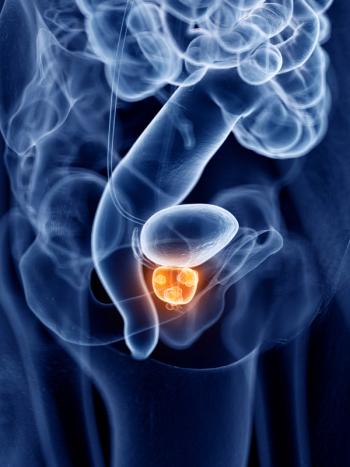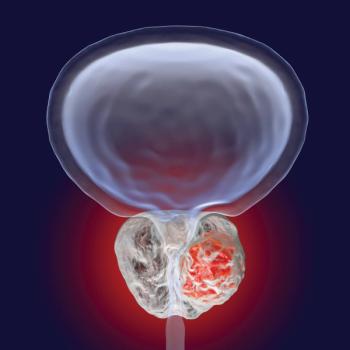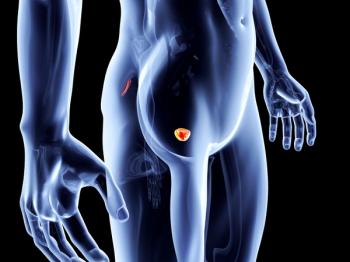
Prostate Cancer
Latest News

Latest Videos

Podcasts
More News

Steven Finkelstein, MD, DABR, FACRO, spoke about the impact of the approval of 177Lu for patients with PSMA-positive mCRPC.

Results from the KEYNOTE-921 trial demonstrated that pembrolizumab with docetaxel did not elicit efficacy improvements vs placebo with docetaxel in prostate cancer.

Prolaris in Practice: Guiding ADT Benefits, Clinical Application, and Expert Insights From ACRO 2025
Steven E. Finkelstein, MD, DABR, FACRO discuses how Prolaris distinguishes itself from other genomic biomarker platforms by providing uniquely actionable clinical information that quantifies the absolute benefit of androgen deprivation therapy when added to radiation therapy, offering clinicians a more precise tool for personalizing prostate cancer treatment strategies.

Alvaro Martinez, MD discusses how emerging genomic risk stratification tools such as the clinical cell-cycle risk (CCR) score are transforming personalized prostate cancer treatment by enabling more nuanced assessments of metastasis risk and treatment intensification strategies beyond traditional NCCN risk groupings.

Daniel Kim, MD, MBA discusses how genomic testing has revolutionized patient selection for active surveillance by integrating molecular insights that transcend traditional clinical parameters, enabling more nuanced risk stratification and personalized management of intermediate-risk prostate cancer.

Dwight E. Heron, MD, MBA, FACRO, FACR discusses how advanced multi-omics approaches, personalized precision medicine techniques, artificial intelligence–driven genetic interpretation tools, and emerging gene editing technologies such as CRISPR (clustered regularly interspaced short palindromic repeats) are poised to revolutionize clinical practice by enabling more targeted diagnostics, predictive risk assessments, and individualized treatment strategies across oncology, rare disease management, and chronic condition prevention.

Christopher Lee, MD discusses how genomic biomarker testing has revolutionized prostate cancer management by enabling a precision medicine approach that transitions from population-based treatments to individualized therapeutic strategies based on precise molecular profiling.

Multidisciplinary collaboration may help in minimizing the treatment burden among patients with prostate cancer, according to Curtiland Deville Jr, MD.

Panelists discuss how PSMA PET imaging plays a crucial role in detecting biochemical recurrence of prostate cancer, offering superior sensitivity and specificity compared with conventional imaging methods. In clinical practice, PSMA PET is typically ordered when there is a rise in prostate-specific antigen (PSA) levels post treatment, indicating potential recurrence. The imaging results significantly influence treatment decisions such as distinguishing between localized salvage therapy and systemic treatments. Pivotal trials have demonstrated the efficacy of various tracers.

Panelists discuss how PSMA PET imaging plays a crucial role in the initial staging of prostate cancer, offering superior accuracy over conventional methods. Medical professionals consider factors such as diagnostic performance, tracer availability, and patient-specific characteristics when selecting appropriate PSMA PET agents. The integration of PSMA PET findings into clinical practice has led to more precise treatment planning, potentially improving patient outcomes. Pivotal trials have demonstrated the efficacy of various PSMA PET tracers in detecting prostate cancer metastases.

The phase 3 MIRAGE trial findings show that PROSTOX ultra was validated as a biomarker to predict genitourinary toxicity following SBRT.

Focused, high-dose radiotherapy doses may prolong survival and the interval to subsequent therapy for patients with advanced prostate cancer.

Data show increasing use of proton therapy overall but widening gaps in populations who have access to this treatment, Curtiland Deville Jr, MD, says.

Panelists discuss how high-quality imaging is crucial for accurately staging prostate cancer, guiding treatment decisions, and optimizing patient outcomes. Superior resolution and sensitivity of PSMA PET tracers enhance lesion detection, influencing surgical, radiation, and systemic therapy choices. Differences in tracer properties impact specificity, affecting treatment planning. Advanced imaging reduces uncertainty, improving risk stratification and therapeutic precision.

Panelists discuss how medical professionals select PSMA PET tracers based on factors such as diagnostic accuracy, tracer availability, patient-specific considerations, and logistical aspects such as half-life and production facilities. Fluorine-18 (^18F)–labeled tracers, such as ^18F-PSMA-1007, offer logistical advantages due to their longer half-life and higher image resolution, facilitating broader clinical application.

Panelists discuss how PSMA PET imaging utilizes various tracers, each with distinct properties influencing image quality and diagnostic accuracy. Fluciclovine F18 (Axumin) is primarily used for detecting recurrent prostate cancer, offering moderate sensitivity but lower specificity compared with PSMA-targeted agents. Gallium Ga 68 gozetotide (Illuccix) provides high sensitivity and specificity for prostate cancer lesions; however, its shorter half-life and limited availability may restrict widespread use. Piflufolastat F18 (Pylarify) combines the benefits of F18’s longer half-life with high image resolution, enhancing detection accuracy. Similarly, flotufolastat F18 (Posluma) leverages F18’s favorable imaging characteristics, offering high-quality images and reliable lesion detection.

Results from PSMAfore show that lutetium Lu 177 vipivotide tetraxetan elicited a median rPFS of 9.3 months vs 5.6 months with ARPI in prostate cancer.

A cohort study found that pre-radical prostatectomy levels greater than 20 ng/mL were associated with increased all-cause mortality risk and prostate cancer-specific mortality risk.

The adverse effect profile was similar among patients with prostate cancer using NeuroSAFE-assisted RARP vs standard RARP.

The new drug application for TLX007-CDx has been approved by the FDA for patients with prostate cancer.

A patient case of a 50-year-old man with hormone-sensitive prostate cancer sparked a debate among oncologists regarding the best course of action.

Prior data support the ability of PATHOMIQ_PRAD to predict patients at a high risk of biochemical recurrence and metastasis.

Results from the phase 1/2a SeCuRE trial support the FDA decision for patients with metastatic castration-resistant prostate cancer.

Data show improvements in overall survival and time to subsequent therapy initiation with darolutamide plus ADT/docetaxel.

Olaparib plus abiraterone improved radiographic PFS and overall survival in mCRPC patients with germline or somatic BRCA mutations vs placebo plus abiraterone.




































































































